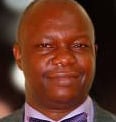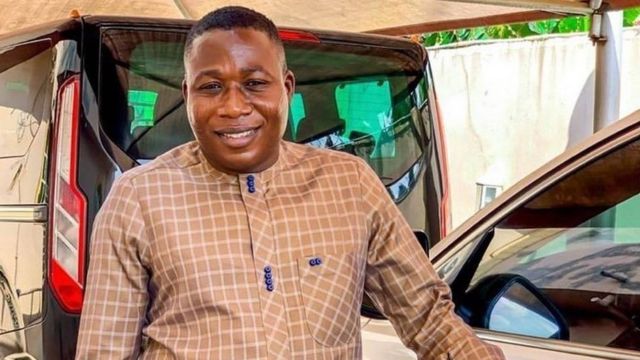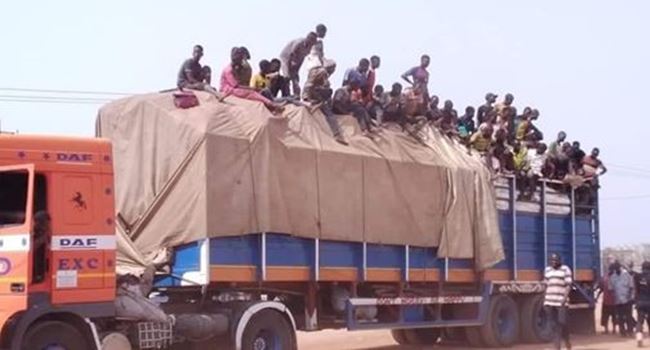An old photograph currently sits regally in the living room of a top Nigerian politician. Shot sometime in 1954, some 67 years ago, ostensibly in the old Osun Division of the Western Region, it was taken after a meeting of monarchs of the Division with Premier of the region, Chief Obafemi Awolowo. The meeting had in attendance almost all first class Obas of Yorubaland. They wore their beaded crowns of Dolly Parton’s Coat of Many Colours hue. After the meeting, the photo session took place.
In the photograph, on the front row was the Premier, sitting in the middle. He wore a resplendent white agbada. Of particular significance was that, Awolowo had his cap removed and held in his hands, apparently in reverence to the Obas. To the left of Awo was Oba Samuel Adenle, the Ataoja of Osogbo. On same front row was Oba Adetoye Laoye, Timi of Ede, donning his animal skin crown. On same row were: Oba Lawani Adeyemi, Akirun of Ikirun; Oba Mosees Oyinlola, Olokuku of Okuku and four other natural rulers. Standing behind Awolowo, without his cap on too, was Chief S. L. Akintola, who by then was the Deputy Leader of the Action Group party. SLA was flanked by other apparently lesser Obas and other people who, from their dressing, must have been chiefs and aides of the Obas of the Osun Division.
Last week, some 67 years after, in the same Yorubaland, a similar meeting held and consequently, another photograph emerged. That photograph spoke eloquently and unambiguously about the tidal wave that has swept off importance, dignity of Yoruba traditional rulers and replaced them with arrogance of the governmental elite. The venue was a security meeting held in the Oyo State governor’s office in Ibadan. Present there were governors, security chiefs and Obas of the Southwest geopolitical zone. They included Governors Rotimi Akeredolu (Ondo), Kayode Fayemi (Ekiti), Dapo Abiodun (Ogun), Gboyega Oyetola (Osun) and host governor, Seyi Makinde. Like the earlier one held 67 years ago, after the meeting, it was time for a photo session and this was the sitting arrangement: The governors, like some matadors, sat on the front row and behind them, standing like cowed captives, were first class natural rulers in Yorubaland, ranging from the Alaafin of Oyo, Oba Lamidi Adeyemi, to the Ooni of Ife and others.
After the Ibadan meeting, I asked a foremost traditional ruler in Oyo State what the place of the Yoruba was in the current precarious equation. He sent me this text: “Take a look at the picture (taken) at the governor’s office yesterday. The Obas stood behind the governors. It cannot happen in the North. We are just being treated like table water on the table during official functions.” It is the same trouble with virtually all parts of Southern Nigeria. After quaffing champagne and whiskey of immense proportion, governors piss on the faces of their monarchs. The other day, Nyesom Wike of Rivers State tongue-lashed the traditional ruler of Omuma, King Onyekachi Amaonwu, whom he accused of shaking his head while he, the Emperor with gruffy voice, spoke.
Advertisement
“Stop shaking your head! You!You! You are one of those who are causing problem. They gave you chieftaincy, you’re a young boy, you don’t know what to do with it and then when I am speaking, you’re shaking your head like this… He will just go and wear something bigger than him. You will think he is an elderly man. I remember when I was in school, he was running around.” Wike lampooned the monarch.
Pens are reputed to be mightier than swords. So are photographs. They are mightier than a thousand words. Photographs evoke metaphors, imageries and diverse interpretations. Krista Neher, an influencer, was quoted to have said that the human brain has a cheetah-speed power to process images 60,000 times faster than words. In a November 15, 2020 piece I wrote entitled The Starved Lion of Kaduna, I cited the award-winning photograph of Kevin Carter, which appeared in The New York Times of March 26, 1993. It was the picture of Kong Nyong, a famine-struck Sudanese boy, initially thought to be a girl. Nyong had collapsed of intense hunger and lay on his face in the hot dessert sun of Sudan, with an empty food bowl hidden beside his face. In the photograph, Nyong also had a beaded necklace of his Sudanese nationality jutting out of his feeble neck. He was said to be on his way to Ayod, the United Nations ration centre in Sudan, a journey of about a half kilometer. All of a sudden, his strength failed him and he collapsed. That picture, which went mega viral, led to Kevin Carter winning the Pulitzer Prize for Feature Photography in 1994. It also provoked events leading to him committing suicide.
Two issues, one interfacing the other, engaged my thoughts as the week that just ended rolled to a close. The first was the photographs above which spoke harmlessly but evocatively about the power of pictures and their constructive and destructive ability. Like Carter’s, it spoke so glibly about the current situation of the Yoruba people of Southwestern Nigeria. This provoked my delving into the second issue personified in a character called Arogidigba in the book Ireke Onibudo, one of the works of D. O. Fagunwa, Yoruba’s pre-colonial master of fantasy literature. Fagunwa deployed phantasm as a tool of literary imagination. Piecing the two issues together and placing them side by side the two photographs above, you can get an explanation into why Yoruba are easy preys in the hands of their present-day Arogidigba.
Advertisement
Aside the photographs, let me delve into the second issue. In pursuit of his phantasm as a literary tool, Fagunwa created queer characters to reinforce his obsession with the fantabulous. In all of his creative and imaginative endeavours, he forged a retinue of unforgettable gothic characters whose names made hairs on the skin stand up. One of such is the ebullient, mythic character he labeled Arogidigba. Sounding almost like some kind of onomatopoeia, Fagunwa’s characters were all carved to create evergreen effects in the mind. The characters were ebullient in their roles and names, garnished in descriptive imageries that drop the jaws in wonder of his literary prowess. The Fagunwa descriptive power was so high that his mastery of labels of animals earned him the sobriquet of a writer-taxonomist.
In Aditu Olodumare, for instance, there was an illustration of Baba Onirugbon Yeuke, the man with a weirdly bushy beard, who cradled his tobacco pipe mysteriously and sat on a hilltop, beside the cusp of a rock. Appended to his illustration in the book was the description: Baba onirugbon yeuke eni ti n gbe ’bi gegele okuta. The characters are also Ajantala, Ogongo Baba Eye (Ostrich, the King of Birds), Ibembe Olokunrun, Aramanda Okunrin, Anjonnu Iberu, Esu Kekereode, Olohun Iyo, Ojola Ibinu and ad infinitum. Each spoke to the character of the characters, thus making this mysterious writer to enrich the mind with fables. Oh, Fagunwa was in a class of his own!
Sorry, I digressed. Another Yoruba great master of cinematography, Tunde Kelani, refreshed our memory of Fagunwa during the week. (By the way, TK clocked 73 last week; Happy birthday, sir). In one of his cinematographic works codifying for posterity imperishable Yoruba literary works, Kelani got Fagunwa’s Ireke Onibudo, written in 1949 read, from Pages 63 to 76. It was the story of the protagonist, Ireke Onibudo, whose boat capsized while on a voyage on the sea. He then found himself right inside the bottom of the sea, arrested by mythic fish world police and taken to the court of the King of the Sea called Arogidigba. Arogidigba was a gothic character who bore an admixture of features of a human being and the physiology of an aquatic being. She also had a long tail affixed to her voluptuous body.
Fagunwa’s descriptive power is awesomely and powerfully deployed here as he brings his characters to you in scarily unambiguous manner. Soon, Ireke Onibudo was shepherded to the front of Arogidigba, whose imperial and beautiful palace, festooned with ornaments, had the inscription, Palace of Arogidigba, King of Fishes. It was there Ireke Onibudo realized that, to celebrate her anniversary on the stool, Arogidigba specifically asked for fleshes of human beings as propitiation to her marine deities. This was reason for the deliberate capsize of Ireke Onibudo’s boat.
Advertisement
As fish palace guards moved to drag their captive to the presence of Arogidigba, the regal fish god shouted an epigrammatic description of humanity which you cannot but find apposite: “Hold it! Human beings must never get close to me! Who is a human being? He is a scorpion that inflicts immense pain on his fellow being, a rattlesnake under the grass; an object poised on a destruction of humanity. Human being possesses a blunt sword and walks aimlessly on the surface of the earth. Who has your God-given majesty, man? Human beings couch daily devious plans against fishes! Small and big fishes are preys in your hands. You kill them aimlessly….” She promised to make Ireke Onibudo’s entrails fill her pot of soup that night.
Now, I return to the two photographs earlier described. Separated in time by 67 years, at a structural level, they speak eloquently and unambiguously about the regression in estimation and importance of the relationship between Yoruba political and natural leaders. 1950s and 1960s Nigeria was when natural rulers and traditional title holders played significant roles in the leadership and governance of their people. All those monumental achievements in Awo’s name could never have been achieved if the traditional institution was playing the united but separated seeds-of-a-walnut role to government. While Sir Adesoji Aderemi was Governor of the Western Region, Odemo of Isara, Samuel Akinsanya, was Minister without Portfolio, between 1952 and 1955. So also was the Aholu Jiwa II of Jegba, Oba Claudius Dosa Akran, who intermixed politics with traditional rulership. He had earlier been nominated as head of Jegba, Badagry quarters in 1948 and appointed traditional leader in 1950. He represented Badagry in the 1951 parliament and was a major member of the Action Group of the Akintola rump who later became regional Minister of Finance between 1962 and 1966.
At the superficial level, the photo issue may sound very inconsequential on the list of the problems that assail Yorubaland. It is however symbolic of the total malaise; of William Butler Yeats’ things that have fallen apart and the falcon that cannot hear the falconer. There is a master/servant relationship today between Southern governmental leaders and their natural rulers. Castrated by the constitution and relegated to playing second fiddle in their jurisdictional enclaves, security-wise, Nigerian governors are powerless. On the insecurity that currently afflicts the south, these governors cannot be said to be strategizing enough, in concert with their natural rulers. These rulers have the ears of their domains. The synergy needed to smoke out blood-sucking Fulani herdsmen who kill and maim their people is absent within them, whereas together, they and the traditional rulers can eliminate the Fulani menace without firing a single shot.
I must however add that the quality of natural rulers has dwindled shamefully. This is the Satanic outcome of appointments of less-than stellar persons into traditional stools. On revered stools today are acknowledged fraudsters, drug addicts and vacant-minded ones. Many of them mount the stool so as to be able to superintend over sales of wide expanse of lands. No one in their right senses can take such characters seriously. One of them recently said, like one under the influence of cannabis, that he would take in smoked out murderous Fulani herdsmen into his domain. Can you blame the governor of his state if he does not strategize with such a fellow?
Advertisement
Right now, Nigeria is literally quaking and gasping for breath. Untrained Almajiri children, the born-trowey – apologies to Patience Jonathan – who, Awolowo warned decades ago, would be our national albatross, have now grown full throttle. They periodically reify their angers against the iniquitous Hausa/Fulani feudal system which literally threw them away, shortly after their births and almost the moment they were weaned. This is manifest in their abduction of schoolchildren, and how they seek ransom from offspring of their leaders who made their lives miserable from infancy. They unleash bloody recompense against the Hausa-Fulani elites and by consequence, the rest of Nigeria.
While growing up as almajiri, they were at the mercy of the northern elite who heap left-over foods at them to eat. Today however, the table has turned. Having now grown into adulthood, that selfsame elite is at their mercy as they kidnap their children and make life unlivable for them. They are the willing recruits of Boko Haram in the Northeast and are the notorious bandits of the Northwest. As at last week, security tracker said that 222 people were killed, 103 kidnapped in seven days in Nigeria and a preponderance of this figure came from the North. The previous week, one of the fat maggots of that feudal system, who today cannot go to his homestead because Boko Haram insurgents have made his ancestral abode inaccessible, blamed southwest leaders for not providing leadership. You would think he was writing a script of dramatic irony.
Advertisement
But in all these, what is the response of southern Nigeria to the impending doom being ferried down South from the North? Reports had it that, towards the tail end of last week, foodstuffs from the North were being stopped in Jebba and diverted to neighbouring African countries. To me, this is great news. It looks like this is the point where the true federalism we canvass and howl about would come into practical manifestation. This should be a wakeup call on the south. Let the South double down on food production.
Do southern Nigerian governors know that they should have a strategic response to the ruinous violence from the northern flank? Because these governors are castrated by the constitution, their traditional rulers are the most appropriate organ that can activate the Southern agenda under the backcloth. Today, Sheikh Gumi, a visceral hater of anyone whose descent isn’t from Fouta Djallon, is traversing northern forests and is not arrested for being an accessory after the fact of the spate of killings in the north. That same system that chose to be blind to Gumi as accessory after the fact of kidnapping and killing, is alive to its responsibility and attempting to arrest Sunday Igboho. Igboho is merely seeking to rescue his people from the hands of people who, in the name of Fulnai nationality, want to wipe them off inside their own domain. Gumi is spewing out very foul outbursts against offspring of those who cultured, from birth, their own children away from a life sans education. In demanding a nebulous amnesty for gun-wielding forest-dwelling bloodhounds, Gumi wants the north to eat its cake and have it. His method is to get the Nigerian state to dedicate chunks of its national proceeds from the oil dredged in the Niger Delta to placate bandits. These are the same people who the Northern feudal system born trowey and have become its open sore. What nonsense!
Advertisement
Neither Muhammadu Buhari, who is the Arogidigba of this destructive system and under whom the Nigerian state has become finally castrated and comatose, nor Yemi Osinbajo, who can conveniently be said to have been captured by Arogidigba and her comity of flesh-eating beings within, can help southern Nigeria formulate the answer needed to the current nuisance of the Nigerian state. You heard the chronology of thoughts of northern governors, senators and top office holders in the last couple of weeks, in defence of killers of their people. Their voices are in support of the same bandits whose lives they fractured right from birth. You think it was a happenstance? No! It is a strategy.
The North, like the Arogidigba, seems to have arrested the South and deactivated its reasoning process. After holding the South captive, it began to spew century-old phlegm on its face like that mythic fish god did on Ireke Onibudo. Similar to what Chinua Achebe said in his The Trouble with Nigeria, the problem of strategic thinking is the trouble with southern Nigeria. The earlier a forward-looking strategy is developed, the better for that region. Not doing this will make Arogidigba harvest Southern Nigerian entrails inside its bloodthirsty pot of soup.
Advertisement
Views expressed by contributors are strictly personal and not of TheCable.






